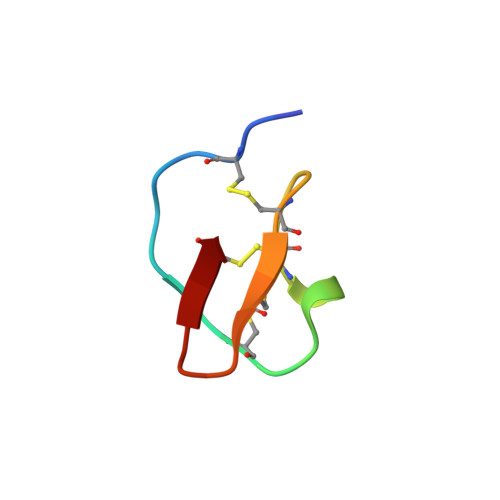Conservative mutation Met8 --> Leu affects the folding process and structural stability of squash trypsin inhibitor CMTI-I.
Zhukov, I., Jaroszewski, L., Bierzynski, A.(2000) Protein Sci 9: 273-279
- PubMed: 10716179
- DOI: https://doi.org/10.1110/ps.9.2.273
- Primary Citation of Related Structures:
2V1V - PubMed Abstract:
Protein molecules can accommodate a large number of mutations without noticeable effects on their stability and folding kinetics. On the other hand, some mutations can have quite strong effects on protein conformational properties. Such mutations either destabilize secondary structures, e.g., alpha-helices, are incompatible with close packing of protein hydrophobic cores, or lead to disruption of some specific interactions such as disulfide cross links, salt bridges, hydrogen bonds, or aromatic-aromatic contacts. The Met8 --> Leu mutation in CMTI-I results in significant destabilization of the protein structure. This effect could hardly be expected since the mutation is highly conservative, and the side chain of residue 8 is situated on the protein surface. We show that the protein destabilization is caused by rearrangement of a hydrophobic cluster formed by side chains of residues 8, Ile6, and Leu17 that leads to partial breaking of a hydrogen bond formed by the amide group of Leu17 with water and to a reduction of a hydrophobic surface buried within the cluster. The mutation perturbs also the protein folding. In aerobic conditions the reduced wild-type protein folds effectively into its native structure, whereas more then 75% of the mutant molecules are trapped in various misfolded species. The main conclusion of this work is that conservative mutations of hydrophobic residues can destabilize a protein structure even if these residues are situated on the protein surface and partially accessible to water. Structural rearrangement of small hydrophobic clusters formed by such residues can lead to local changes in protein hydration, and consequently, can affect considerably protein stability and folding process.
- Institute of Biochemistry and Biophysics, Polish Academy of Sciences, Warszawa, ul. Pawinskiego.
Organizational Affiliation:
















